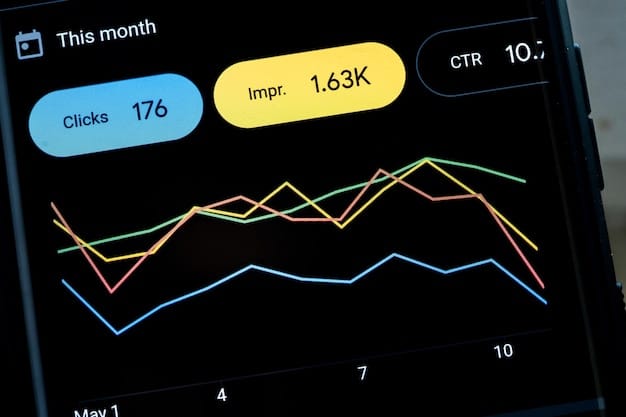E-commerce Data Analytics Companies: Investing in Personalization

E-commerce data analytics companies offer solutions to optimize customer experience through personalization, leveraging data to provide targeted insights and tailored experiences that drive growth and improve efficiency in the e-commerce sector.
The digital marketplace is evolving at an unprecedented pace, and businesses are increasingly turning to data to gain a competitive edge. Investing in e-commerce data analytics companies: investing in the future of personalization is not just about keeping up; it’s about staying ahead.
Understanding E-commerce Data Analytics
E-commerce data analytics refers to the process of collecting, analyzing, and interpreting data generated by online retail activities. This data encompasses a wide range of information, from customer demographics and browsing behavior to transaction history and marketing campaign performance.
Key Components of E-commerce Data Analytics
Several components are essential for effective e-commerce data analytics, providing a comprehensive view of the business and its customers.
- Data Collection: Gathering data from various touchpoints, including website interactions, mobile apps, and CRM systems.
- Data Processing: Cleaning, transforming, and organizing the collected data into a structured format for analysis.
- Data Analysis: Applying statistical techniques and machine learning algorithms to identify patterns, trends, and insights.
- Reporting and Visualization: Presenting the findings in an accessible and actionable format through dashboards and reports.
By understanding these components, e-commerce businesses can harness the full potential of their data to make informed decisions and improve their overall performance.
Benefits of Implementing Data Analytics
Implementing data analytics in e-commerce can lead to significant improvements across various aspects of the business.
- Improved Customer Experience: Personalizing the shopping experience based on customer preferences and behavior.
- Increased Sales: Optimizing product recommendations and marketing campaigns to drive conversions.
- Enhanced Operational Efficiency: Streamlining processes and reducing costs through data-driven insights.
- Better Inventory Management: Predicting demand and optimizing stock levels to minimize waste and maximize profitability.
The benefits are clear: data analytics is a critical tool for any e-commerce business looking to thrive in today’s competitive market.

In conclusion, understanding and implementing data analytics is crucial for e-commerce businesses aiming to enhance customer experience, increase sales, improve operational efficiency, and optimize inventory management.
The Rise of Personalization in E-commerce
Personalization has transformed from a mere buzzword into a fundamental strategy in e-commerce. Customers today expect tailored experiences, and businesses that fail to deliver risk losing market share.
Data analytics plays a vital role in enabling personalization by providing insights into customer preferences, behaviors, and needs.
Understanding Customer Needs Through Data
By analyzing data, businesses can gain a deep understanding of their customers, allowing them to create personalized experiences that resonate.
- Behavioral Data: Tracking browsing history, purchase patterns, and product views to identify customer interests.
- Demographic Data: Using age, gender, location, and other demographic information to segment customers and tailor marketing messages.
- Psychographic Data: Analyzing customer values, attitudes, and lifestyles to create more meaningful and relevant content.
- Feedback Data: Gathering customer reviews, ratings, and survey responses to understand satisfaction levels and areas for improvement.
This understanding allows businesses to tailor their offerings to meet the unique needs of each customer, fostering loyalty and driving repeat purchases.
Advanced Personalization Techniques
Beyond basic personalization, advanced techniques leverage data to create highly customized and engaging experiences.
- Product Recommendations: Suggesting products based on browsing history, purchase patterns, and demographic data.
- Personalized Content: Displaying tailored content, such as blog posts, articles, and videos, based on customer interests.
- Dynamic Pricing: Adjusting prices based on customer behavior, demand, and other factors to maximize revenue.
- Personalized Email Marketing: Sending targeted email campaigns with customized offers and content based on customer preferences.

These advanced techniques can significantly enhance the customer experience, leading to increased engagement and higher conversion rates.
In summary, the rise of personalization in e-commerce is driven by the need to meet evolving customer expectations, and data analytics is the key to unlocking the power of tailored experiences.
Key Players in E-commerce Data Analytics
The e-commerce data analytics landscape is populated by numerous companies offering a wide range of solutions. These companies vary in size, specialization, and the types of services they provide.
Several key players have emerged as leaders in this field, helping e-commerce businesses leverage data to drive growth and improve performance.
Leading Data Analytics Companies
Some of the top data analytics companies that cater to the e-commerce sector include:
- Google Analytics: A widely used web analytics service that provides insights into website traffic, user behavior, and marketing campaign performance.
- Adobe Analytics: A comprehensive analytics platform that offers advanced features for tracking and analyzing customer interactions across multiple channels.
- Mixpanel: A product analytics tool that focuses on user behavior within web and mobile applications, providing insights into user engagement and retention.
- Heap: An analytics platform that automatically captures user interactions, allowing businesses to analyze data without manual tracking setup.
These companies offer a variety of tools and services to help e-commerce businesses understand their customers and optimize their operations.
Niche Data Analytics Providers
In addition to the major players, several niche providers specialize in specific areas of e-commerce data analytics.
- Retention Science: Focuses on customer retention and engagement, providing tools for personalized marketing campaigns and customer lifecycle management.
- Optimizely: Specializes in A/B testing and experimentation, allowing businesses to test different website variations and optimize for conversions.
- CQuotient: Offers personalized product recommendations and marketing automation tools for e-commerce businesses.
- Bluecore: Provides a customer data platform (CDP) that enables businesses to unify customer data from multiple sources and create personalized experiences.
These niche providers offer specialized solutions that can complement the offerings of larger analytics platforms.
In conclusion, the e-commerce data analytics landscape is diverse, with a range of companies offering solutions to meet the specific needs of businesses operating in this sector.
Investing in Data Analytics: A Strategic Imperative
Investing in e-commerce data analytics is no longer a luxury but a strategic imperative for businesses looking to thrive in the digital age. The ability to collect, analyze, and interpret data is critical for making informed decisions and staying ahead of the competition.
A well-crafted data analytics strategy can provide a significant return on investment, leading to increased sales, improved customer satisfaction, and enhanced operational efficiency.
Building a Data-Driven Culture
To fully realize the benefits of data analytics, businesses must foster a data-driven culture that permeates all aspects of the organization.
- Leadership Buy-In: Ensuring that senior management supports and champions the use of data in decision-making.
- Cross-Functional Collaboration: Encouraging collaboration between different departments, such as marketing, sales, and operations, to share data and insights.
- Training and Education: Providing employees with the skills and knowledge they need to understand and use data effectively.
- Data Governance: Establishing policies and procedures to ensure data quality, security, and compliance.
A data-driven culture can empower employees to make better decisions, leading to improved outcomes across the organization.
Measuring the ROI of Data Analytics
Measuring the return on investment (ROI) of data analytics is essential for justifying the investment and demonstrating its value to stakeholders.
- Key Performance Indicators (KPIs): Identifying and tracking KPIs that are directly impacted by data analytics, such as conversion rates, customer retention, and average order value.
- Attribution Modeling: Using attribution models to understand the impact of different marketing channels and campaigns on sales and revenue.
- A/B Testing: Conducting A/B tests to measure the impact of changes and optimizations based on data-driven insights.
- Customer Satisfaction Surveys: Gathering feedback from customers to understand how data analytics is impacting their experience.
By carefully measuring and tracking the ROI of data analytics, businesses can demonstrate its value and ensure that it is delivering the desired results.
In summary, investing in e-commerce data analytics is a strategic imperative for businesses looking to thrive in the digital age, and building a data-driven culture is essential for realizing its full potential.
Future Trends in E-commerce Data Analytics
The field of e-commerce data analytics is constantly evolving, with new technologies and techniques emerging to help businesses gain even deeper insights into their customers and operations.
Several key trends are shaping the future of e-commerce data analytics, including artificial intelligence (AI), machine learning (ML), and real-time analytics.
The Role of AI and Machine Learning
AI and machine learning are playing an increasingly important role in e-commerce data analytics, enabling businesses to automate tasks, personalize experiences, and predict future outcomes.
- Predictive Analytics: Using machine learning algorithms to predict future customer behavior, such as purchase patterns, churn rates, and lifetime value.
- Personalized Recommendations: Leveraging AI to generate personalized product recommendations based on customer preferences and browsing history.
- Fraud Detection: Using machine learning to identify and prevent fraudulent transactions in real-time.
- Chatbots and Virtual Assistants: Deploying AI-powered chatbots and virtual assistants to provide customer support and answer questions.
AI and machine learning can help businesses make more informed decisions and improve their overall performance.
Real-Time Analytics
Real-time analytics is another key trend in e-commerce data analytics, enabling businesses to monitor performance and respond to changes in real-time.
- Live Dashboards: Monitoring key performance indicators (KPIs) in real-time through interactive dashboards.
- Real-Time Personalization: Personalizing the customer experience based on real-time behavior and preferences.
- Dynamic Pricing: Adjusting prices in real-time based on demand, competition, and other factors.
- Real-Time Inventory Management: Monitoring inventory levels in real-time and adjusting stock levels accordingly.
Real-time analytics can help businesses stay agile and respond quickly to changing market conditions.
In conclusion, the future of e-commerce data analytics is being shaped by AI, machine learning, and real-time analytics, enabling businesses to gain deeper insights, automate tasks, and personalize experiences.
Challenges and Considerations
While investing in e-commerce data analytics offers numerous benefits, businesses must also be aware of the challenges and considerations involved.
These challenges include data privacy, data quality, and the need for skilled personnel.
Data Privacy and Security
Data privacy and security are paramount concerns for e-commerce businesses, and they must comply with regulations such as the General Data Protection Regulation (GDPR) and the California Consumer Privacy Act (CCPA).
- Obtaining Consent: Obtaining explicit consent from customers before collecting and using their data.
- Data Encryption: Encrypting data both in transit and at rest to protect it from unauthorized access.
- Data Minimization: Collecting only the data that is necessary for a specific purpose.
- Data Retention: Retaining data only for as long as it is needed and securely deleting it when it is no longer required.
By prioritizing data privacy and security, businesses can build trust with their customers and avoid costly fines and reputational damage.
Ensuring Data Quality
Data quality is another critical consideration, as inaccurate or incomplete data can lead to flawed insights and poor decision-making.
- Data Validation: Implementing data validation processes to ensure that data is accurate and consistent.
- Data Cleansing: Cleansing data to remove errors, inconsistencies, and duplicates.
- Data Governance: Establishing data governance policies and procedures to maintain data quality over time.
- Data Monitoring: Monitoring data quality on an ongoing basis to identify and address any issues.
By ensuring data quality, businesses can have confidence in the insights they are generating and make better decisions.
In summary, while investing in e-commerce data analytics offers numerous benefits, businesses must be aware of the challenges and considerations involved, including data privacy, data quality, and staffing needs.
| Key Point | Brief Description |
|---|---|
| 📊 Data Analytics | Collecting and analyzing e-commerce data for insights. |
| 🛍️ Personalization | Tailoring e-commerce experiences to individual customers. |
| 🚀 ROI | Measuring returns on data analytics investments. |
| 🔒 Privacy | Ensuring data privacy and security compliance. |
Frequently Asked Questions
▼
E-commerce data analytics involves collecting, analyzing, and interpreting data from online retail activities to gain insights into customer behavior, sales trends, and operational efficiency.
▼
Personalization enhances customer experience by tailoring products, content, and marketing to individual preferences, leading to increased engagement, loyalty, and sales.
▼
Businesses can ensure data privacy by obtaining consent, encrypting data, minimizing data collection, and complying with regulations like GDPR and CCPA to protect customer information.
▼
Future trends include the increasing use of AI and machine learning for predictive analytics, personalized recommendations, and real-time analytics to monitor and respond to market changes.
▼
ROI can be measured by tracking KPIs like conversion rates, customer retention, and average order value, using attribution models, A/B testing, and gathering customer satisfaction feedback.
Conclusion
Investing in e-commerce data analytics companies presents a pivotal opportunity to enhance personalization strategies. As data becomes more integral to business decisions, selecting the right analytics partner can drive significant improvements in customer engagement, sales growth, and overall operational efficiency.





